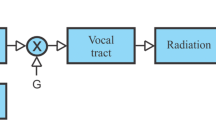Abstract
THE portions of sound film tracks reproduced in Fig. 1 are from registrations of the vowels oo (as in boo), ee (as in bee), ah (as in bah), ay (as in bay), æ (from a in an). The registration in each case shows a series of contiguous short bits of vibration in each of which the movement begins strongly and fades rapidly to zero. Such a movement occurs only as a free vibration, that is, as the movement of a vibratory system disturbed in its equilibrium and then left to itself. A vibration of this kind is produced when the air in the vocal cavity is rarefied or condensed by snapping the thumb out of the mouth or by closing and suddenly opening the glottis. Such a sudden rarefaction or condensation may be termed a puff. Repeated puffs will produce a series of free vibrations.
Similar content being viewed by others
References
See NATURE, 130, 275; 1932.
Author information
Authors and Affiliations
Rights and permissions
About this article
Cite this article
SCRIPTURE, E. Puff and Profile Theory of the Vowels. Nature 136, 435–436 (1935). https://doi.org/10.1038/136435c0
Issue Date:
DOI: https://doi.org/10.1038/136435c0
- Springer Nature Limited




